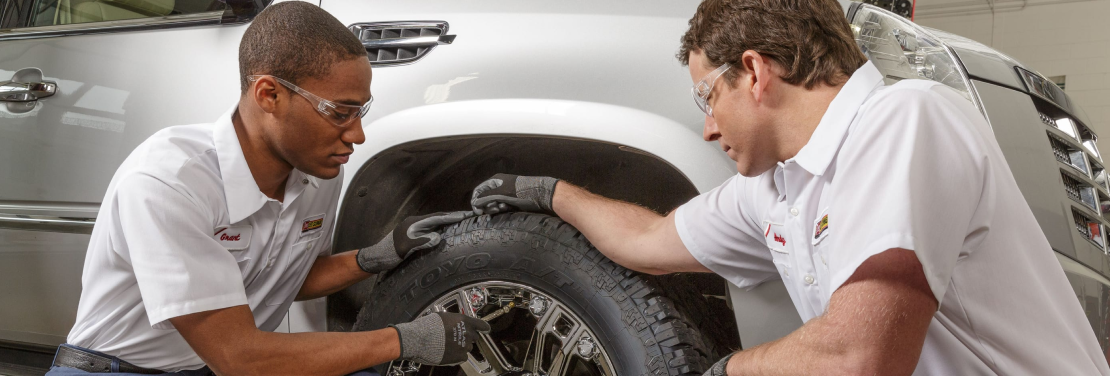Tire Solution: The Effect of Weather
When it concerns making certain optimal efficiency and security on the road, comprehending the effect of weather condition conditions on tire solution is important. From scorching warmth to icy roads, each weather condition aspect can considerably affect tire functionality and general driving experience. By delving into the impacts of varying weather problems on tires, motorists can acquire useful understandings that might enhance their car's efficiency and durability. In this discussion, we will certainly check out the intricate relationship between weather condition problems and tire service, dropping light on the significance of weather-specific tire upkeep practices and considerations.
Warmth and Tire Performance
When subjected to high temperatures, tires experience adjustments in efficiency that can substantially impact automobile safety and handling. The heat created from long term driving or heat problems creates the tire rubber to soften, resulting in decreased step life and increased wear. As the rubber becomes softer, the tire's grasp when traveling lessens, affecting stopping ranges and general grip. In severe instances, extreme warmth can also trigger tire blowouts, posturing a serious safety and security danger to the vehicle and its residents.
Moreover, heats can speed up the procedure of tire aging, creating the rubber to wear away faster. This can lead to cracks, bulges, and various other kinds of damage that compromise the structural integrity of the tire. To alleviate the results of heat on tire efficiency, motorists should routinely check their tire pressure, turn tires to make sure even use, and inspect for any kind of signs of damage. In addition, using tires particularly created to hold up against high temperatures can assist preserve optimum performance and safety and security on the road.
Winter Impacts
Cold climate conditions can have a considerable impact on tire efficiency and safety and security. In cold weather condition, tires may also shed air pressure much more quickly, which can affect handling and fuel effectiveness.
To mitigate the effects of cool weather condition on tires, it is important to frequently inspect tire stress and inflate them to the supplier's suggested levels. Making use of winter season or all-season tires developed for winter conditions can additionally enhance traction and grasp on icy or snowy roads - discount tires morris il. Appropriate tire upkeep, including normal evaluations for wear and damages, ends up being also extra critical throughout cooler months to ensure ideal efficiency and security
Rainy Issues Impact
During rainy conditions, tire performance and safety and security can be significantly influenced by the wet road surfaces and reduced visibility. The step pattern of tires plays an important role in maintaining grip on damp roadways. Tires with worn-out treads are much more prone to hydroplaning, where a layer of water builds up in between the roadway and the tire surface area, causing loss of traction. To combat this, vehicle drivers need to regularly evaluate their tires for appropriate walk depth and take into consideration purchasing tires especially created for wet problems.

Snow and Tire Safety
When driving in snowy conditions, having the right tires can make a considerable distinction in security and performance. Winter tires are developed with special rubber compounds and step patterns to offer much better traction on snow and ice contrasted to all-season tires.
In addition to using winter season tires, it is vital to guarantee they are effectively blown up. Winter can cause tire pressure to go down, influencing grip and handling (tire shop morris). On a regular basis examining and preserving the right tire pressure is vital for ideal efficiency in snowy problems

Weather-Related Tire Maintenance
When confronted with various climate problems, appropriate tire upkeep becomes a critical element of car safety and security and performance. Weather-related tire upkeep incorporates a variety of practices focused on guaranteeing optimum tire function and durability in various weather situations. One vital aspect of weather-related tire maintenance is tire stress law. Varying temperature levels can cause tire pressure to vary, influencing grip and fuel efficiency. On a regular basis adjusting and inspecting tire pressure according to producer referrals is essential for safe driving in altering weather condition problems. Additionally, tire walk depth plays a considerable duty in taking care of different climate elements. Tires with adequate tread depth provide far better grasp on wet or icy roads, minimizing the danger of hydroplaning or skidding. When tread wear gets to a particular deepness is important for preserving grip and security in damaging climate, checking tire walk frequently and changing tires. By prioritizing weather-related tire maintenance, drivers can boost safety and security, enhance lorry efficiency, and lengthen the life expectancy of their tires.
Final Thought
In conclusion, climate conditions have a substantial effect on tire efficiency and security. From warmth impacting tire stress and wear to cool climate lowering traction, it is necessary to think about the climate when maintaining and using tires. Rainy conditions can lower grip and cause hydroplaning, while snow can increase the threat of accidents if tires are not appropriately equipped. Weather-related tire maintenance is critical in guaranteeing optimum efficiency and safety and security when driving.
In this discussion, we will check out the detailed connection in between climate problems and tire service, shedding light on the significance of weather-specific tire maintenance practices and factors to consider.
